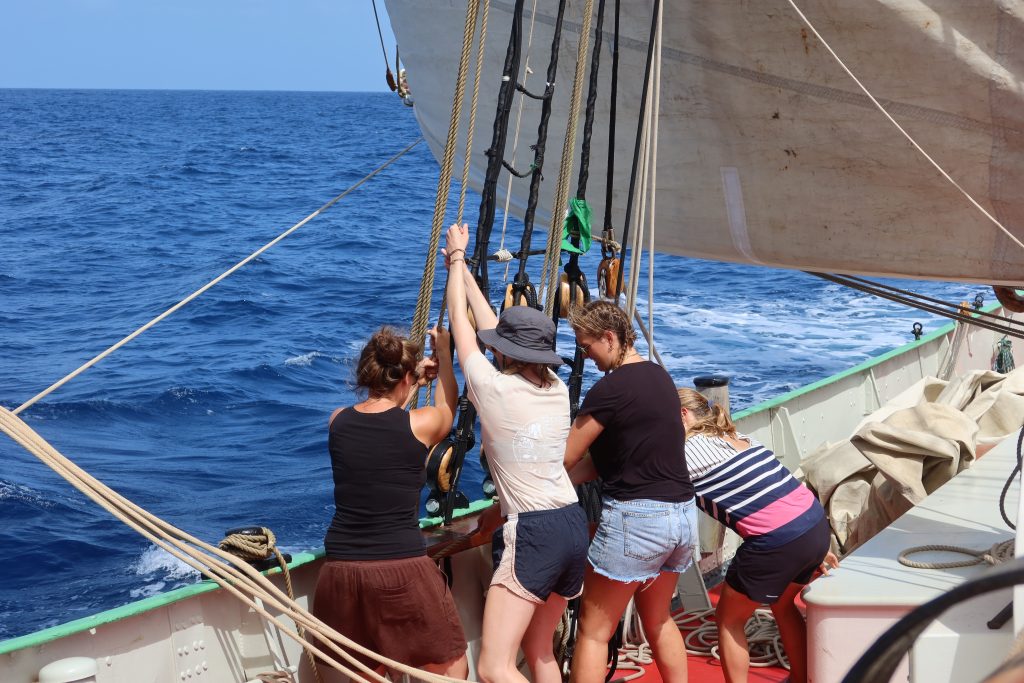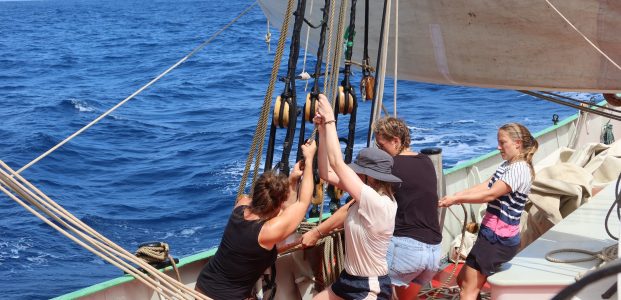Reading: An Unsung Hero (Michael Smith) & Dead Lions – Mick Herron (finished)
Weather: E 2-4 – got up a little during the day. Sunny ….
Thought for the day: Sweating a line is very appropriately named – it is perhaps the sweatiest job on board!
Evening meal: Nasi Goreng with fried rice, fried onion, cucumbers in soy
Course: 175oC
Distance covered: At 1200 we had done 2,737 miles and at 1300 the distance to arrival in Brazil was 1,305 miles
Wildlife headcount: A much quieter day today – just a few flying fish.
The breeze got up a little overnight so at the 6am watch changeover we changed down to the smaller jib again. The morning watch then saw us averaging nearly 8 knots over the ground, though a small part of that may be that we have picked up the south-going Brazilian current. Nevertheless, a good morning’s sailing. The wind stayed a little higher though, so at the lunchtime changeover the main came down. The throat was checked for chafe and then we re-hoisted the sail with one reef in. Our speed scarcely dropped.
Sail handling always means us splitting into teams. Dropping the main for example, requires one team on the throat halyard, one on the peak halyard and one person on the topsail sheet to prevent the gaff flying around too much as it comes down. Getting it up again is another story – particularly putting a reef in at the same time. The loads on each halyard often mean switching around to ensure enough muscle power to get it all in the air. This means knowing your way around the racks of belaying pins. There are four racks of pins – two each side. On one side, level with the mainmast, is the throat halyard (around a 4:1), but on the opposite side (port) is the throat jigger or stretcher. This is an 8:1 tensioner for the halyard. In the same way, the peak halyard is on the port side, but the jigger is on the starboard side. Pulling on any one of them means at least two but generally three or four people if any tension is required. Two people grab the halyard as it comes down and pull downwards while another two pull horizontally where the halyard comes out of the block on deck. Timing is everything with someone calling it – the purpose of pulling sea shanties becomes very clear. If everyone pulled randomly the result would be equally random. Teamwork is essential. Once it gets tight, you then take one turn round the belaying pin and start sweating it up – pulling out and down in one fluid movement and then holding the tension while working it back towards the pin for the others to take up the tension. In this weather sweating the line could not be a better name for it ….. When the maximum tension is on the line the two holding the vertical part hold tight while the person nearest the belaying pin secures it – always with a locking hitch as the last turn on the pin.


